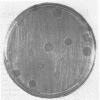Abstract
A bacteriophage-typing scheme for the differentiation and classification of clinically isolated strains of Serratia marcescens was developed. Thirty-four Serratia bacteriophages were isolated from sewage and used to type 185 of 204 isolates (90.6%) of S. marcescens into 23 bacteriophage groups representing 71 types. Different bacteriophage types occurred at different intervals, suggesting that particular strains of S. marcescens are found at certain times. A correlation was found between inositol fermentation and bacteriophage type and between susceptibility to carbenicillin and bacteriophage type. However, there was no relationship between source of isolate and bacteriophage type. Bacteriophage typing of S. marcescens should provide a system which will aid in determining the origin of nosocomial Serratia infections.
Full text
PDF







Images in this article
Selected References
These references are in PubMed. This may not be the complete list of references from this article.
- Alexander R. H., Reichenbach D. D., Merendino K. A. Serratia marcescens endocarditis. A review of the literature and report of a case involving a homograft replacement of the aortic valve. Arch Surg. 1969 Mar;98(3):287–291. doi: 10.1001/archsurg.1969.01340090063007. [DOI] [PubMed] [Google Scholar]
- Allen S. D., Conger K. B. Serratia marcescens infection of the urinary tract: a nosocomial infection. J Urol. 1969 Apr;101(4):621–623. doi: 10.1016/s0022-5347(17)62391-7. [DOI] [PubMed] [Google Scholar]
- Barnabas J., Goodman M., Moore G. W. Evolution of hemoglobin in primates and other therian mammals. Comp Biochem Physiol B. 1971 Jul 15;39(3):455–482. doi: 10.1016/0305-0491(71)90192-1. [DOI] [PubMed] [Google Scholar]
- Bodey G. P., Rodriguez V., Smith J. P. Serratia sp. infections in cancer patients. Cancer. 1970 Jan;25(1):199–205. doi: 10.1002/1097-0142(197001)25:1<199::aid-cncr2820250128>3.0.co;2-4. [DOI] [PubMed] [Google Scholar]
- Brown W. J., Paris J. T. Bacteriophage typing of bacteriuric Escherichia coli. Proc Soc Exp Biol Med. 1966 Jan;121(1):259–262. doi: 10.3181/00379727-121-30751. [DOI] [PubMed] [Google Scholar]
- Cabrera H. A. An outbreak of Serratia marcescens, and its control. Arch Intern Med. 1969 Jun;123(6):650–655. [PubMed] [Google Scholar]
- Clayton E., Von Graevenitz A. Nonpigmented Serratia marcescens. JAMA. 1966 Sep 26;197(13):1059–1064. [PubMed] [Google Scholar]
- Davis J. T., Foltz E., Blakemore W. S. Serratia marcescens. A pathogen of increasing clinical importance. JAMA. 1970 Dec 21;214(12):2190–2192. doi: 10.1001/jama.214.12.2190. [DOI] [PubMed] [Google Scholar]
- Dodson W. H. Serratia marcescens septicemia. Arch Intern Med. 1968 Feb;121(2):145–150. [PubMed] [Google Scholar]
- Farmer J. J., 3rd Epidemiological differentiation of Serratia marcescens: typing by bacteriocin production. Appl Microbiol. 1972 Feb;23(2):218–225. doi: 10.1128/am.23.2.218-225.1972. [DOI] [PMC free article] [PubMed] [Google Scholar]
- Farmer J. J., 3rd Epidemiological differentiation of Serratia marcescens: typing by bacteriocin sensitivity. Appl Microbiol. 1972 Feb;23(2):226–231. doi: 10.1128/am.23.2.226-231.1972. [DOI] [PMC free article] [PubMed] [Google Scholar]
- Hamilton R. L., Brown W. J. Medium to aid identification of Serratia marcescens. Am J Med Technol. 1972 Mar;38(3):73–76. [PubMed] [Google Scholar]
- Sanders C. V., Jr, Luby J. P., Johanson W. G., Jr, Barnett J. A., Sanford J. P. Serratia marcescens infections from inhalation therapy medications: nosocomial outbreak. Ann Intern Med. 1970 Jul;73(1):15–21. doi: 10.7326/0003-4819-73-1-15. [DOI] [PubMed] [Google Scholar]
- TAYLOR G., KEANE P. M. Cross-infection with Serratia marcescens. J Clin Pathol. 1962 Mar;15:145–147. doi: 10.1136/jcp.15.2.145. [DOI] [PMC free article] [PubMed] [Google Scholar]
- Traub W. H., Raymond E. A. Epidemiological surveillance of Serratia marcescens infections by bacteriocin typing. Appl Microbiol. 1971 Dec;22(6):1058–1063. doi: 10.1128/am.22.6.1058-1063.1971. [DOI] [PMC free article] [PubMed] [Google Scholar]
- Traub W. H., Raymond E. A., Startsman T. S. Bacteriocin (Marcescin) typing of clinical isolates of Serratia marcescens. Appl Microbiol. 1971 May;21(5):837–840. doi: 10.1128/am.21.5.837-840.1971. [DOI] [PMC free article] [PubMed] [Google Scholar]
- Turck M., Ronald A. R., Clark H., Winterbauer R. H., Atlas E., Silverblatt F., Petersdorf R. G. Studies on the epidemiology of Escherichia coli, 1960-1968. J Infect Dis. 1969 Jul;120(1):13–16. doi: 10.1093/infdis/120.1.13. [DOI] [PubMed] [Google Scholar]
- WASSERMANN M. M., SELIGMANN E. Serratia marcescens bacteriophages. J Bacteriol. 1953 Jul;66(1):119–120. doi: 10.1128/jb.66.1.119-120.1953. [DOI] [PMC free article] [PubMed] [Google Scholar]
- Wilfert J. N., Barrett F. F., Ewing W. H., Finland M., Kass E. H. Serratia marcescens: biochemical, serological, and epidemiological characteristics and antibiotic susceptibility of strains isolated at Boston City Hospital. Appl Microbiol. 1970 Feb;19(2):345–352. doi: 10.1128/am.19.2.345-352.1970. [DOI] [PMC free article] [PubMed] [Google Scholar]
- Wilkowske C. J., Washington J. A., 2nd, Martin W. J., Ritts R. E., Jr Serratia marcescens. Biochemical characteristics, antibiotic susceptibility patterns, and clinical significance. JAMA. 1970 Dec 21;214(12):2157–2162. doi: 10.1001/jama.214.12.2157. [DOI] [PubMed] [Google Scholar]




